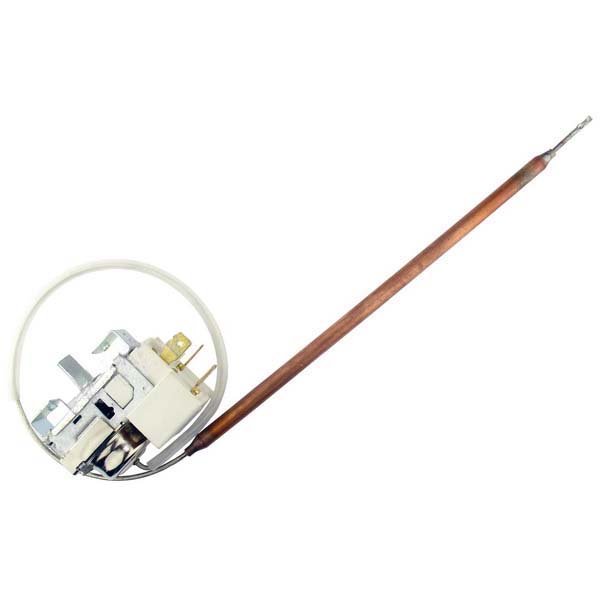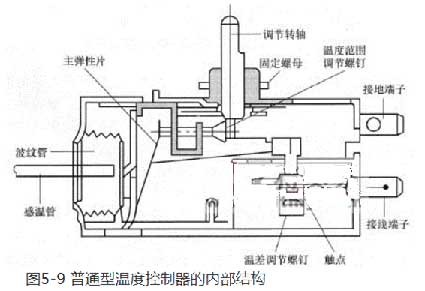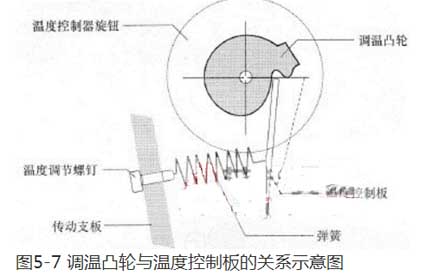Internal Structure, Working Principle and Common Faults of Semi-automatic Defrosting Temperature Controller
The semi-automatic defrost temperature controller is commonly used in single-door refrigerators and is capable of manual defrost auto reset. As shown in Figure 5-10, there is a button in the center of the temperature controller's thermostat knob. When the button is pressed, the compressor will stop running and defrost. When the temperature of the temperature sensing tube reaches about 5 °C, the temperature controller automatically resets and the compressor starts again.

The internal structure of the semi-automatic defrost type temperature controller is shown in Figure 5-11.

At normal temperature, the temperature controller's switch is always on (except for the knob to the forced shutdown position). Otherwise, it indicates that the temperature controller has been damaged, which is usually caused by leakage of temperature sensor or poor contact due to oxidation of contacts. At normal temperature, the defrost button of the semi-automatic defrost temperature controller should be bounced immediately after pressing.
This temperature controller and the ordinary temperature controller have the same working principle and structure, except that a defroster device is added to the ordinary temperature controller, as shown in Figure 5-12.

This temperature controller is used in a refrigerator. On the one hand, the temperature inside the refrigerator can be adjusted and controlled like a normal temperature controller. On the other hand, when the frost layer on the evaporator surface is too thick, it can defrost automatically.
When defrosting is required, the refrigeration compressor will stop working as long as the defrosting button is pressed. When the temperature in the box reaches the predetermined defrosting temperature (generally the surface temperature of the evaporator is about 5 °C, the temperature in the middle of the box is about 10 °C), the defrost button will automatically jump and the refrigeration compressor will resume operation.
When the defrost button is not pressed, the defrost spring does not add an external force to the spring (main spring). If the defrost button is pressed to perform defrosting, the drive support plate will open the contact under the action of the defrost spring, and the compressor will stop running. When the temperature in the refrigerator reaches the expected defrosting end temperature, the pressure generated by the thermostat in the thermostat can push the main lever to overcome the resistance moment of defrosting spring to the defrosting control plate besides the defrosting balance spring. The defrost balance spring is used to compensate for the change in the tension of the defroster spring when the temperature adjustment cam is rotated at different positions. For example, when the temperature adjustment cam rotates from the cold spot to the hot spot, the resistance torque of the defrost balance spring increases, but the forward torque of the defrost balance spring also increases, so that the temperature of the temperature adjustment cam is at different positions, the defrost end temperature No change will happen.

The internal structure of the semi-automatic defrost type temperature controller is shown in Figure 5-11.

At normal temperature, the temperature controller's switch is always on (except for the knob to the forced shutdown position). Otherwise, it indicates that the temperature controller has been damaged, which is usually caused by leakage of temperature sensor or poor contact due to oxidation of contacts. At normal temperature, the defrost button of the semi-automatic defrost temperature controller should be bounced immediately after pressing.
This temperature controller and the ordinary temperature controller have the same working principle and structure, except that a defroster device is added to the ordinary temperature controller, as shown in Figure 5-12.

This temperature controller is used in a refrigerator. On the one hand, the temperature inside the refrigerator can be adjusted and controlled like a normal temperature controller. On the other hand, when the frost layer on the evaporator surface is too thick, it can defrost automatically.
When defrosting is required, the refrigeration compressor will stop working as long as the defrosting button is pressed. When the temperature in the box reaches the predetermined defrosting temperature (generally the surface temperature of the evaporator is about 5 °C, the temperature in the middle of the box is about 10 °C), the defrost button will automatically jump and the refrigeration compressor will resume operation.
When the defrost button is not pressed, the defrost spring does not add an external force to the spring (main spring). If the defrost button is pressed to perform defrosting, the drive support plate will open the contact under the action of the defrost spring, and the compressor will stop running. When the temperature in the refrigerator reaches the expected defrosting end temperature, the pressure generated by the thermostat in the thermostat can push the main lever to overcome the resistance moment of defrosting spring to the defrosting control plate besides the defrosting balance spring. The defrost balance spring is used to compensate for the change in the tension of the defroster spring when the temperature adjustment cam is rotated at different positions. For example, when the temperature adjustment cam rotates from the cold spot to the hot spot, the resistance torque of the defrost balance spring increases, but the forward torque of the defrost balance spring also increases, so that the temperature of the temperature adjustment cam is at different positions, the defrost end temperature No change will happen.





